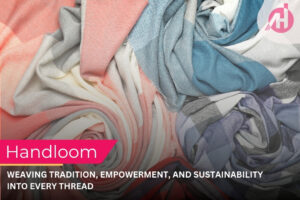In the world of textiles, the choice between handloom and machine-made fabrics is significant, reflecting not just differences in production methods, but also in cultural heritage, quality, and environmental impact. This blog delves into these differences, helping you understand why each type of fabric holds its unique place in the industry.
What is Handloom Fabric?
Handloom fabrics are woven on traditional hand-operated looms, a technique that dates back thousands of years. The process involves a skilled artisan manually interlacing threads to create fabric, allowing for intricate designs and unique textures that machine-made fabrics often cannot replicate.
Characteristics of Handloom Fabrics:
- Artisanal Craftsmanship: Each piece of handloom fabric carries the distinct touch of the weaver, often showcasing elaborate patterns and textures that reflect cultural traditions.
- Quality and Durability: Handloom fabrics are generally known for their superior quality. The meticulous weaving process often results in stronger and more durable fabrics.
- Customization: Artisans can create custom designs and patterns, allowing for a higher degree of personalization.
- Environmental Impact: Handloom weaving is usually more eco-friendly as it doesn’t require electricity and often uses natural dyes and sustainable practices.
Popular Handloom Fabrics:
- Khadi: A fabric made from cotton, silk, or wool, hand-spun and hand-woven, popular in India.
- Ikat: A dyeing technique used to create patterned fabrics, common in Southeast Asia.
- Tussar Silk: A type of silk produced by silkworms in the wild, known for its rich texture.
What is Machine-Made Fabric?
Machine-made fabrics are produced using industrial looms and machinery, allowing for high-speed production and large quantities. This method has revolutionized the textile industry by making fabrics more affordable and accessible.
Characteristics of Machine-Made Fabrics:
- Consistency: Machine-made fabrics offer uniformity in texture, pattern, and color, ensuring consistency across large batches.
- Cost-Effectiveness: Production on a larger scale reduces costs, making machine-made fabrics more affordable.
- Variety: Machines can produce a wide range of fabrics, from basic cottons to complex synthetics, with numerous finishes and treatments.
- Speed: The efficiency of machinery allows for rapid production, meeting high demand quickly.
Popular Machine-Made Fabrics:
- Polyester: A synthetic fabric known for its durability and resistance to wrinkles.
- Nylon: A strong, lightweight fabric often used in outdoor gear and clothing.
- Rayon: A semi-synthetic fabric made from regenerated cellulose, offering a silky feel.
Comparing Handloom and Machine-Made Fabrics
1. Quality and Craftsmanship:
- Handloom fabrics are often considered superior in quality due to the meticulous weaving process and the use of natural fibers. They also embody cultural significance and artisanal skill.
- Machine-made fabrics are consistent and reliable, but may lack the unique characteristics and personal touch of handloom fabrics.
2. Environmental Impact:
- Handloom fabrics generally have a lower environmental footprint, with minimal energy use and sustainable practices. However, the impact can vary depending on the materials used.
- Machine-made fabrics, especially synthetic ones, can have a higher environmental impact due to the use of non-renewable resources and chemical processes.
3. Cost and Accessibility:
- Handloom fabrics are often more expensive due to the labor-intensive process and the value of craftsmanship.
- Machine-made fabrics are more affordable and widely available, making them a practical choice for mass production.
4. Customization and Variety:
- Handloom fabrics offer unparalleled customization and unique designs, often reflecting traditional patterns and cultural heritage.
- Machine-made fabrics provide a vast array of choices and finishes, catering to a wide range of needs and preferences.
Conclusion
Choosing between handloom and machine-made fabrics depends on your priorities—whether you value artisanal craftsmanship, environmental sustainability, cost-effectiveness, or variety. Both types of fabrics have their own strengths and play essential roles in the textile industry. By understanding these differences, you can make informed choices that align with your values and needs.






